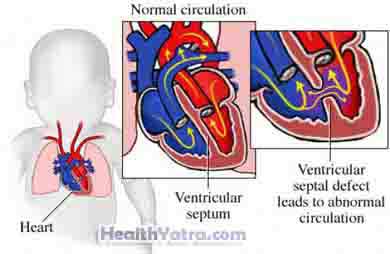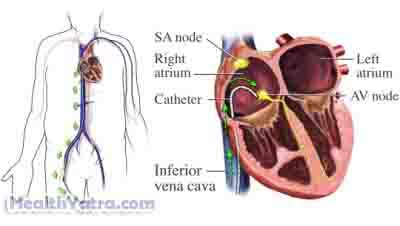Ventricular Septal Defect Treatment Cost in India
A ventricular septal defect (VSD) is a defect in the wall (septum) between the heart’s two lower chambers (ventricles). A septal defect is often referred to as a “hole” in the heart.
Normally, the right side of the heart receives oxygen-poor blood and pumps it to the lungs where it is filled with oxygen. The blood is then sent back to the left side of the heart, which pumps oxygen-rich blood to the rest of the body. But with VSD, the heart pumps inefficiently. The oxygen-rich blood is pumped back to the lungs.
VSD can lead to enlargement of the heart and high blood pressure in the blood vessels of the lungs (called pulmonary hypertension). VSDs are usually diagnosed in infancy, and many close on their own. Those that do not close can be treated with surgery.

Causes
Most VSDs are a type of congenital heart defect, meaning they are present at birth. It is unclear why VSDs develop, but genetics may play a part. Although rare, some VSDs can occur after a heart attack.
Risk Factors
These factors increase your chance of developing this condition. Tell your doctor if you have any of these risk factors:
- Age: young infants and children
- Parent with a septal defect
- Other genetic defects (eg, Down syndrome)
- Use of alcohol or thalidomide during pregnancy
- Rubella during the first trimester of pregnancy
- Maternal diabetes
Symptoms
Small VSDs may not cause any symptoms. If your child experiences any of these symptoms, do not assume they are due to a VSD. These may be caused by other, less serious health conditions. If your child experiences any one of them, call the doctor.
Symptoms include:
- Heart murmur, which may be heard at birth or when the baby is 6-8 weeks old
- Signs of heart failure during infancy
- Difficulty feeding
- Poor growth
Diagnosis
Your doctor will ask about your child’s symptoms and medical history. The exam will include listening to your child’s heart to detect a heart murmur. If a heart problem is suspected, your child will likely be referred to a pediatric cardiologist. This is a doctor who specializes in heart problems in babies and children.
Tests may include the following:
- Echocardiogram —a test that uses high-frequency sound waves (ultrasound) to examine the size, shape, and motion of the heart
- Electrocardiogram (ECG, EKG)—a test that records the heart’s activity by measuring electrical currents through the heart muscle
- Chest x-ray —a test that uses radiation to take a picture of structures inside the body, especially bones
- Pulse oximetry—used to measure the amount of oxygen in the blood
- Cardiac catheterization —a thin, flexible tube passed into the right or left side of the heart to look for abnormalities in the arteries that supply blood to the heart
- Blood tests

Treatment
Talk with your doctor about the best treatment plan for you or your child. Treatment options include the following:
Watchful Waiting
More than half of VSDs will close on their own. So if there are no signs of heart failure, your doctor may recommend periodic check-ups to see if the defect closes on its own.
Surgery
Surgery is often recommended to repair large VSDs that cause symptoms or that have not closed by one year of age. Surgery for a VSD involves open heart surgery to place a patch over the hole.
Extra Nutrition
In cases of VSD in which a child fails to gain weight, extra nutrition may be needed. This consists of high-calorie formulas, breast milk supplements, and tube-feedings.
Prevention
Since it is unclear what causes congenital VSDs, there is no known way to prevent them. Acquired VSDs may be prevented by early treatment of heart attacks.
